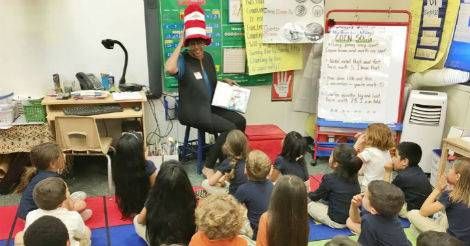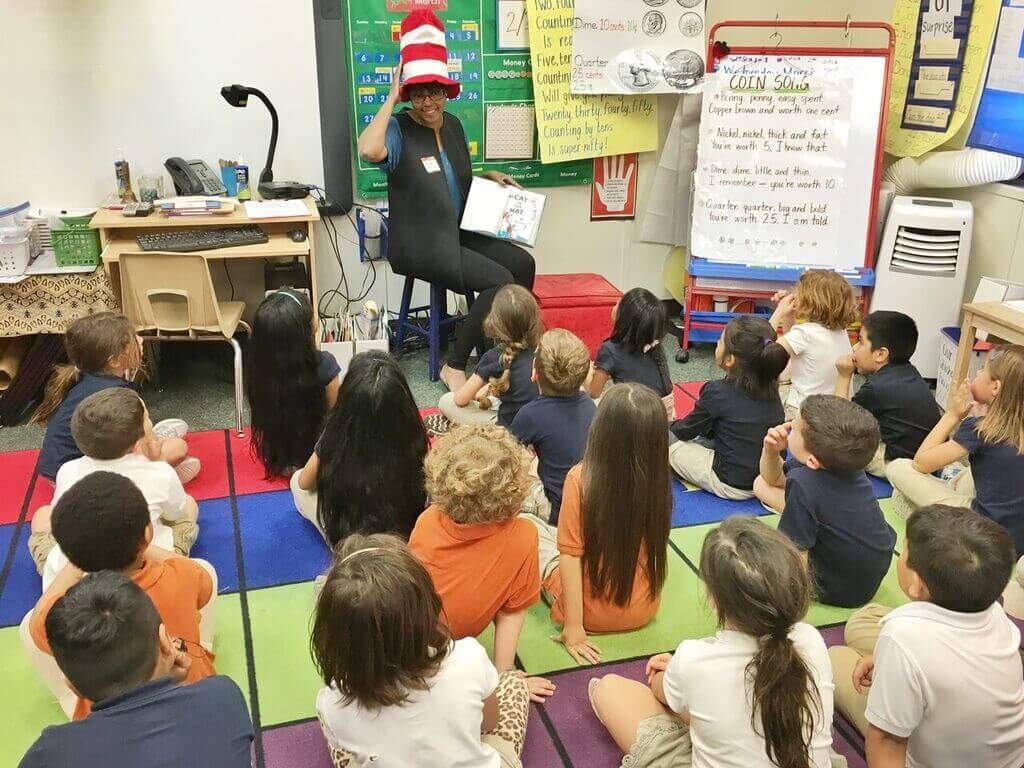
How To Be a Read-Aloud Rockstar

I celebrated Dr. Seuss’s 112th birthday by donning a red and white stovepipe hat and reading The Cat in the Hat to eager first graders at a local elementary school.
On my way over, I worried that the book selection was too young for them. As the mom of a four-year-old, I knew the elementary schoolers should have mastered Cat in the Hat vocabulary years ago. They’re beginning readers, I thought, but they’re veteran listeners too. A chapter book might better capture their attention.
Turns out I needn’t have worried. The Cat in the Hat was the perfect selection for the occasion because the day was about reading inspiration, not reading instruction. Their teachers work day in and day out on building the phonics, phonemic awareness, vocabulary, fluency and comprehension the students need to excel at school and in the world.
As a special guest, by contrast, I was invited to party. That is, to celebrate the beloved author, connect with the students, and represent the community of care surrounding their school. The content of the book was secondary to the fact of a community member’s presence in the classroom and the quality of our storytime conversation.
As I read, it was obvious that the kids knew the book inside and out. They jumped in to provide words at the end of each rhyme and broke into smiles and laughter in anticipation of coming catastrophe. I paused along the way to ask questions like, Do you think that’s a good idea? Or What would you do in this situation? They loved the conversation around the book, asked questions of their own and brought me up to speed on the differences among the book, television series, play and movie versions of the book.
We talked about authorship, media, and creativity. One student even shared her struggle to read another Seuss text, Green Eggs and Ham. When I asked what her work to master the text revealed about her, classmates piped in with big-kid vocabulary. “Tenacity,” one shouted. “Optimism,” another said. “Courage,” another concluded, while fellow students nodded in agreement.
This kind of book talk is really the heart of guest readership. A fresh voice is invited into the classroom to spur conversation that might not otherwise take place and give kids fun book-related experiences.
By the time I turned in my Seuss hat, I felt like a read-aloud rockstar. Not because of my animated reading performance or page-turning fluency (they were just okay), but because I’d effectively engaged 20 finicky first-graders in a wide-ranging, laughter-filled conversation about books, authorship, and resiliency in the face of challenges. I donated a few non-Seuss titles for the classroom library and left, fondly recalling all the ways the kids had schooled me. Next are some of the lessons I’ll take with me to my next classroom read-aloud.
Nine Ways to Share Book Love As A Guest Reader
Do your homework. Read the book in advance, no matter how simple the text, so that you can read with style. Look up interesting author tidbits and backstory to share with your listeners.
Connect the dots. Introduce yourself and express excitement about the chance to meet them and read a treasured story to them. Talk about your favorite book or why reading is so important to you.
Set the stage. Read the title, author and illustrator, even if you think they know it already. It can create a great opportunity to discuss how books are made, who shapes their development and the relationship between stories on the page and on screen.
Read well. You don’t have to give an Academy Award worthy performance, but it’s important to model the book love, expression and fluency the kids should aspire to. Use your voice to convey humor and drama.
Pause with a purpose. When reading familiar texts, stop periodically to give the listeners a chance to fill in the words or guess what happens next. It makes the session more interactive and keeps kids engaged.
Dress for success. Costumes and props add visual interest to storytime. They help the reader get into character and capture the listener’s attention before a word is uttered.
Keep cool. Kids will be kids so don’t let their movement, spontaneous shouts or waving arms throw you off kilter. It’s not easy to sit criss-cross applesauce at length, especially when you’re enthralled with a good story and excited about a classroom visitor.
Parting words. Don’t read and run. Allow time for discussion and questions at the end of the reading. Books that are discussed are remembered. Talking after the book reinforces understanding–and enjoyment.
Bring a Hostess Gift. It’s also wonderful to leave behind a memento of your visit–a themed bookmark or trinket for each child or a larger gift for the classroom that ties into the reading’s theme.











